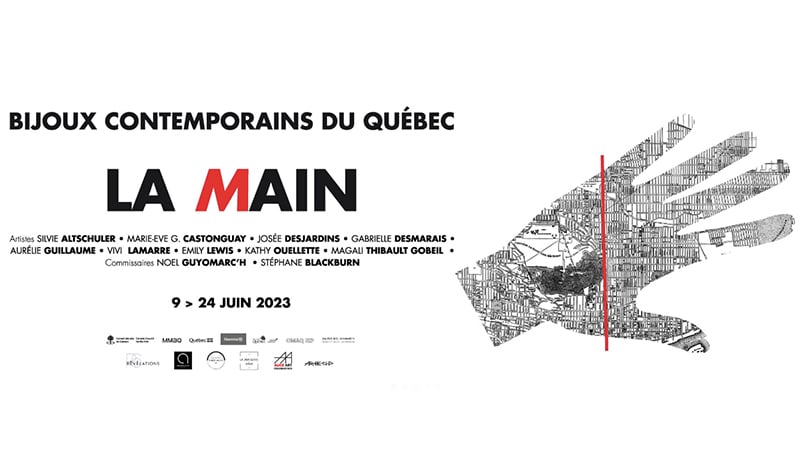
Scroll down to read the translation.


Barbara Stutman, by Noel Guyomarc’h
Before embarking on a career as an artist-jeweller, Barbara Stutman started out as a painter, studying at the École des beaux arts de Montréal under Arthur Lismer, Guido Molinari and Patrick Landsley. Her figurative works revealed the feminist concerns that she would later explore in her work as a jeweller. Following this promising debut, she discovered art jewellery during a visit to an exhibition at the Saidye Bronfman Centre for the Arts (now the Segal Centre for Performing Art)and that same year, signed up for jewellery-making courses.
While continuing her studies, Stutman participated in a number of workshops in professional development and creative exploration. At that time, few schools in Quebec offered professional training in jewellery-making; craft and knowledge were passed from masters to apprentices. In 1973, Madeleine Dansereau, Quebec’s first female professional jeweller, who trained with Philippe Vauthier, and Armand Brochard, a jeweller originally from Belgium, established the Atelier de joaillerie, which would later become the École de joaillerie de Montréal. Along with complete formal training, this studio-school offered various workshops facilitated by Canadian and international artists, including several women who were the among the field’s earliest practitioners, such as Wendy Ramshaw, Lois Etherington Betteridge and Mary Ann Scherr. Through encounters with these artists Stutman found answers to her questions relating to the technical, formal and conceptual aspects of jewellery-making.
Stutman’s earliest works are characterized by their size and a raw, unrefined quality inspired by primitive art. However, a workshop in textile art techniques, led by American jewellery artist Mary Lee Hu, was a turning point in Stutman’s early career. From then on, she applied the techniques of crocheting and knitting, which she had learned as a child from her grandmother, to jewellery making.
For several years, Stutman explored the potential uses of fine silver and gold wire, occasionally incorporating unusual materials such as rubber, neoprene, and plastic in these pieces, and was delighted to discover coloured copper wire, which gave her work a whole new dimension. While continuing studies in art history and anthropology at Concordia University—an influence that can be seen in her early collections—Stutman’s production took a different turn in the 1990s. She embraced narrative-style jewellery, the result of reflection of a social and political nature. At the time, two of her major collections provoked much debate and discussion. Plotting Our Progress/L’État de la Femme deals with such controversial topics as incest, rape and plastic surgery, while Impaired Visions denounces the stereotypical images of women that are portrayed in the media. Two important influences were Frida Kahlo, the Mexican painter, and Art Spiegelman, the author of socially engaged comic books.
Stutman permits herself, through jewellery—objects that communicate—to criticize certain points of view. Using brooches, rings and necklaces, she expresses, satirically, the perverse effects of images in the media that she perceives to be a barrier to the emancipation of women. Her use of textile techniques, something we associate with traditionally female crafts or pastimes, reinforces this stance. To acquire and wear one of her works requires courage and commitment; the wearer becomes a standard-bearer of certain taboo subjects, many of which are still very much in the news.
In 2000, Stutman set aside this narrative approach, instead devoting herself to exploring the history of the sumptuous jewellery of the Indian subcontinent and its inherent value. The aesthetic and extravagance of this jewellery inspired her Royal Series. The central elements made of crocheted coloured copper wire and tiny glittering glass beads are reminiscent of the crown jewels of the Maharajas. With this collection, Stutman evokes the exploitation of humans and the environment brought about by the mining of gold and precious stones.
In contrast to the materials and labour-intensive nature of the pieces in the Royal Series, Stutman is now working on a collection titled Imperfect Beauty, using wire, black elastic thread and beads of different sizes to create works that have a raw, unfinished and accidental appearance.
Active for close to 40 years, and recognized as a major artist by her peers, Barbara Stutman has taken part in many national and international exhibitions, demonstrating a constant evolution in her work. Her work has been featured in numerous articles, in addition to appearing in many respected publications. A number of her pieces can be found in museum collections in Canada and abroad, including the Montreal Museum of Fine Arts, the Racine Art Museum (Wisconsin) and the Museum of Arts Design (New York).




